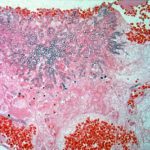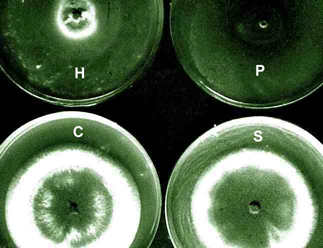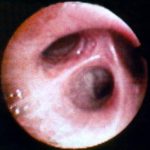Date: 26 November 2013
The growth isolated from the aspergilloma in the presence of living cells of the three bacterial species in culture.The most marked inhibition occurred with Pseudomonas aeruginosa(P) and Haemophilus influenzae(H) and to a much lesser extent with Staphylococcus aureus(S). C=control. Inhibitory factors were components of the bacterial slime layers.
Copyright:
Fungal Research Trust
Notes:
Colonies on CYA 40-60 mm diam, plane or lightly wrinkled, low, dense and velutinous or with a sparse, floccose overgrowth; mycelium inconspicuous, white; conidial heads borne in a continuous, densely packed layer, Greyish Turquoise to Dark Turquoise (24-25E-F5); clear exudate sometimes produced in small amounts; reverse pale or greenish. Colonies on MEA 40-60 mm diam, similar to those on CYA but less dense and with conidia in duller colours (24-25E-F3); reverse uncoloured or greyish. Colonies on G25N less than 10 mm diam, sometimes only germination, of white mycelium. No growth at 5°C. At 37°C, colonies covering the available area, i.e. a whole Petri dish in 2 days from a single point inoculum, of similar appearance to those on CYA at 25°C, but with conidial columns longer and conidia darker, greenish grey to pure grey.
Conidiophores borne from surface hyphae, stipes 200-400 µm long, sometimes sinuous, with colourless, thin, smooth walls, enlarging gradually into pyriform vesicles; vesicles 20-30 µm diam, fertile over half or more of the enlarged area, bearing phialides only, the lateral ones characteristically bent so that the tips are approximately parallel to the stipe axis; phialides crowded, 6-8 µm long; conidia spherical to subspheroidal, 2.5-3.0 µm diam, with finely roughened or spinose walls, forming radiate heads at first, then well defined columns of conidia.
Distinctive features
This distinctive species can be recognised in the unopened Petri dish by its broad, velutinous, bluish colonies bearing characteristic, well defined columns of conidia. Growth at 37°C is exceptionally rapid. Conidial heads are also diagnostic: pyriform vesicles bear crowded phialides which bend to be roughly parallel to the stipe axis. Care should be exercised in handling cultures of this species.
Images library
-
Title
Legend
-
Further details
Image G. Patient was a 9 year old girl 5 months post matched unrelated donor (MUD) bone marrow transplantation with T-cell depletion, with reduced respiratory function (dyspnoea), cough and crackles at the bases, without fever. Donor and recipient were CMV antibody negative. 5/10/98.
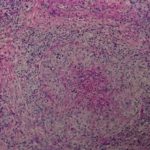 ,
,  ,
,  ,
, 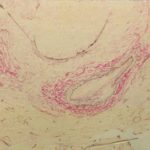 ,
, 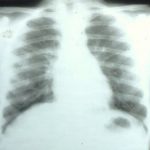 ,
,  ,
, 
-
Fluorescence microscopy was performed on the same sample as blankophor® staining according to Ruchel R. & Margraf S. 1993, Mycoses 36, 239-242. The artefactual staining of fibres and cellular elements is due to previous drying of the smear and recedes with time.
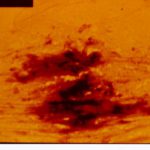
-
A needle biopsy of a solitary round infiltrate found near the thoracic wall in a patient with acute lymphoblastic leukaemia was gram-stained and then treated with an alkaline solution of the whitening agent Blankophor®.
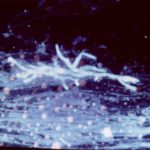
-
Medium power view (H&E) of cerebral abscess in which there are hyphae consistent with Aspergillus. Aspergillus fumigatus was grown from adjacent tissue.
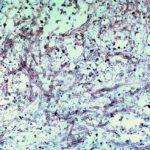
-
Medium power view (GMS) of kidney invaded by Aspergillus. The walls of the hyphae stain black. There are plentiful fungal hyphae within two glomeuli and there is also fungal invasion of adjacent cortical interstitial tissue.
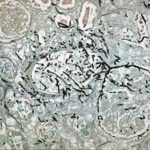
-
High power view (H&E) of uniform septate hyphae which show typical diclotomous branding characteristic of Aspergillus taken from mitral valve vegetation in a patient with disseminated aspergillosis. The hyphae are present within a background of fibrinous material.
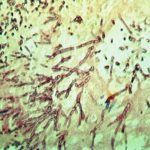
-
Medium power view (H&E) of lung tissue in patient with invasive pulmonary aspergillosis in which many of the fungal hyphae are seen in cross section.
